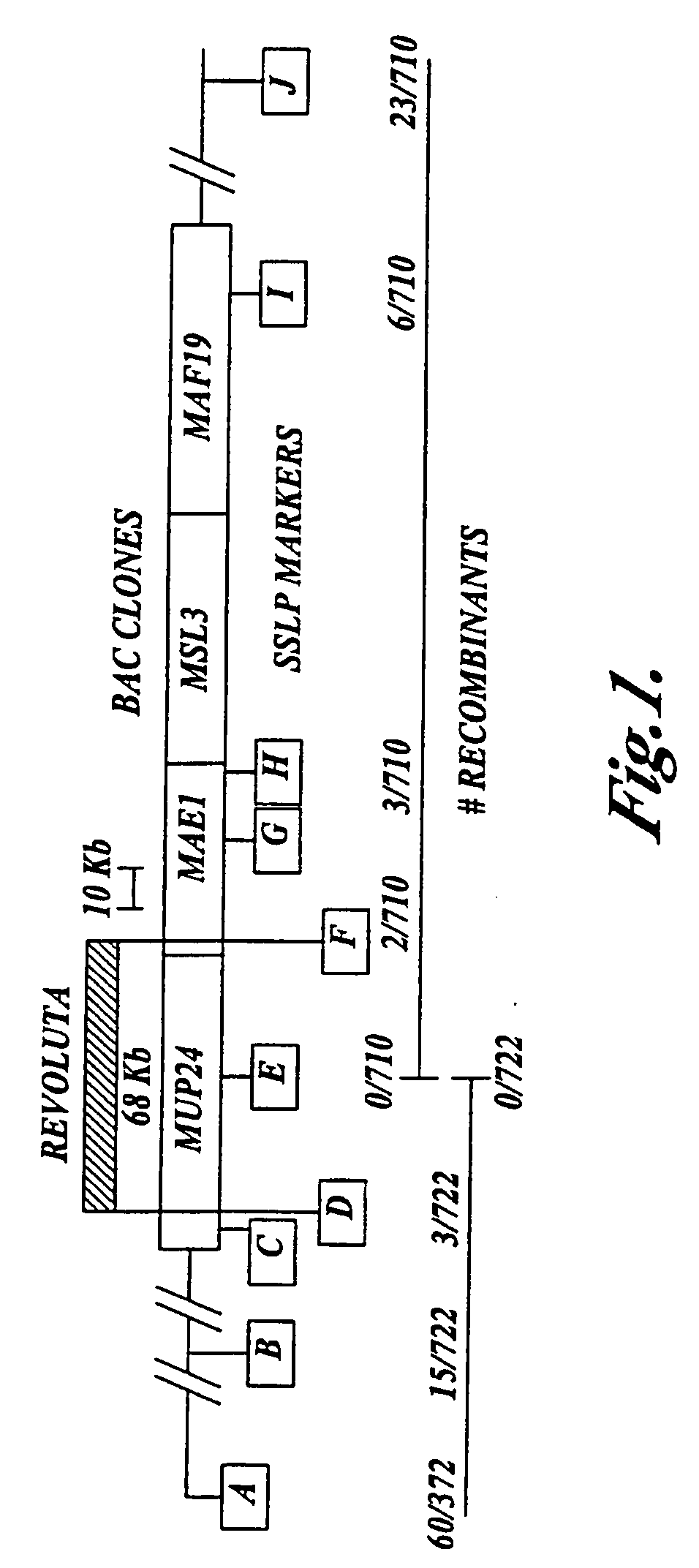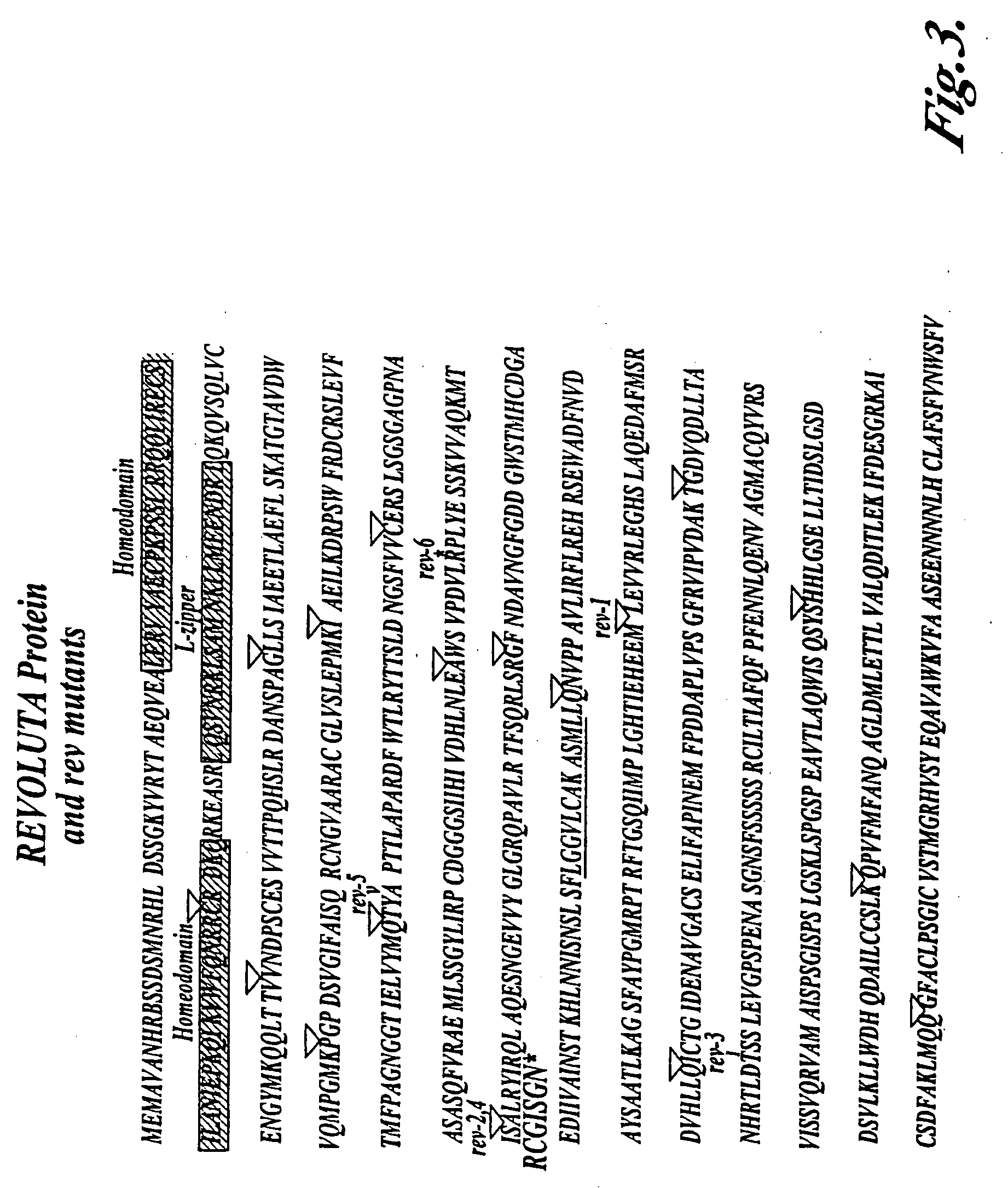Compositions and methods for modulation of plant cell division
a technology of plant cell division and composition, applied in the field of composition and methods for modulating plant cell division, can solve the problems of difficult visual identification of plant morphology phenotypes, and increasing the number of cells and the size of these tissues, so as to improve the expression or decrease the expression, modulate the division of plant cells, and alter the level of revoluta protein
- Summary
- Abstract
- Description
- Claims
- Application Information
AI Technical Summary
Benefits of technology
Problems solved by technology
Method used
Image
Examples
example 1
Identification of REVOLUTA
Mapping the REVOLUTA Gene Using Polymorphic DNA Markers
[0135] To map a gene using small differences or polymorphisms in the DNA, a segregating population of Arabidopsis derived from two different ecotypes was screened. To generate this segregating population, a homozygous plant containing mutations in the revoluta gene (rev-1) of the Nossen (No) ecotype was crossed to a wild-type plant of the Landsberg erecta (Ler) ecotype. In the resulting F1 progeny, one chromosome of each pair was of the No ecotype, and the other was of the Ler ecotype. All the F1 progeny contained the rev-1 mutation from the No parent and a wild-type REVOLUTA gene from the Ler parent. One of these F1 progeny (called 21A) was allowed to self-fertilize and to produce F2 seeds in which recombination between the No and Ler chromosomes would have occurred. The F2 plants grown from these seeds were segregating for the different polymorphisms or markers and for the rev-1 mutation.
[0136] In...
example 2
REVOLUTA Clones and Expression Vectors
[0147] A variety of recombinant DNA clones have been made that contain the wild-type REVOLUTA gene isolated from genomic DNA obtained from Arabidopsis ecotypes Columbia (Co) and Nossen (No) ecotypes. In addition, genomic DNA clones have been obtained from revoluta mutants: rev-1, rev-2, rev-3, rev-4, rev-5 and rev-6. Revoluta mutants rev-1, rev-2 and rev-4 are in the No ecotype background and the rev-3, rev-5 and rev-6 mutants are in Columbia. Overlapping regions of wild-type Columbia Revoluta cDNA were cloned separately into a vector for sequencing. The cDNA sequenced included approximately 350 nucleotides of untranslated 5′ sequence, the entire Revoluta coding region and approximately 400 nucleotides of untranslated 3′ sequence. The wild-type Columbia REV cDNA sequence was in agreement with the predicted spliced nucleotide sequence available on the Kazusa database site [www.kazusa.or.jp / arabi / chr5 / clone / MUP24 / index.html].
Expression of REVOL...
example 3
Complementation of Revoluta Mutants Using REVOLUTA Transgenes
[0153]Agrobacterium strain At503 was transformed with the above constructs and cocultivated with root explants from rev-1 and wild-type Nossen 2-3 week old seedlings (Valvekens et al., 1988 Proc. Nat. Acad. Sci. USA 85:5536-5540). Regenerated plants from this tissue are analyzed for complementation of the rev phenotype by comparing the transformed plants to the nontransformed rev mutant plants. Alternatively, Arabidopsis plants expressing a Revoluta transgene can be made using in planta transformation (Bechtold et al., 1998 Methods Mol. Biol. 82:259-266). Gene expression of the transgenes is determined by performing Northern blot hybridization assays using Revoluta transgene specific hybridization probes that do not hybridize significantly to endogenous Revoluta mRNA. Alternatively, Revoluta gene expression is measured by performing reverse transcriptase reactions on isolated mRNA samples and than using copy DNA from the ...
PUM
| Property | Measurement | Unit |
|---|---|---|
| Tm | aaaaa | aaaaa |
| temperature | aaaaa | aaaaa |
| pH | aaaaa | aaaaa |
Abstract
Description
Claims
Application Information
 Login to View More
Login to View More - R&D
- Intellectual Property
- Life Sciences
- Materials
- Tech Scout
- Unparalleled Data Quality
- Higher Quality Content
- 60% Fewer Hallucinations
Browse by: Latest US Patents, China's latest patents, Technical Efficacy Thesaurus, Application Domain, Technology Topic, Popular Technical Reports.
© 2025 PatSnap. All rights reserved.Legal|Privacy policy|Modern Slavery Act Transparency Statement|Sitemap|About US| Contact US: help@patsnap.com



